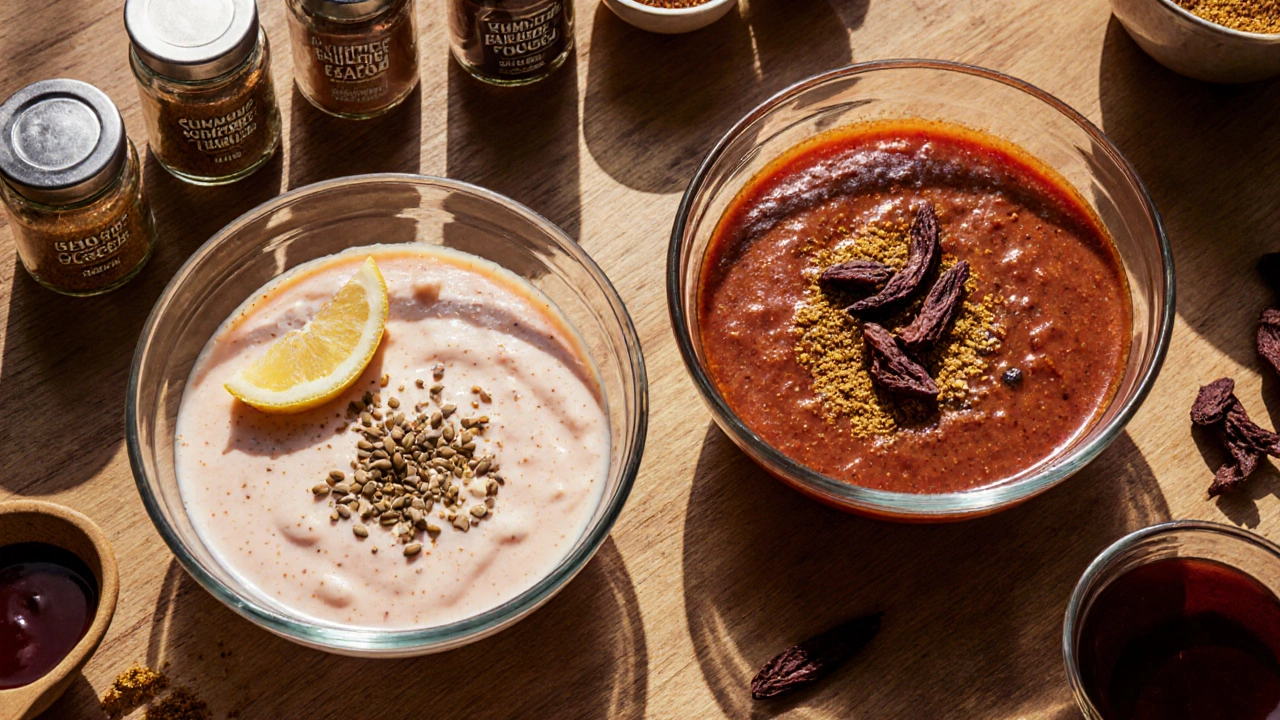Tandoori Sauce: Flavor, Uses, and Everyday Tips
When working with tandoori sauce, a vibrant, smoky condiment made from yogurt, spices, and a hint of lemon. Also known as tandoori gravy, it transforms simple meats into classic Indian barbecues. The sauce’s core relies on a tandoor oven, a clay oven that reaches intense heat, giving the signature char, while a balanced spice blend, usually featuring cumin, coriander, paprika, and garam masala drives its bold aroma. A smooth yogurt marination, the tenderizing base that keeps meat juicy under high heat completes the formula. Together these pieces make tandoori sauce the heart of Indian BBQ.
The sauce isn’t just for meat. Veggies, paneer, and even cauliflower soak up its tangy heat, turning a side dish into a star. Because the yogurt base is slightly acidic, it helps break down proteins, which means faster cooking and softer texture—perfect for busy kitchens. Health‑wise, the sauce offers probiotic benefits from the cultured yogurt, while the spices add antioxidants. If you watch salt, you can lower the sodium by using low‑salt spices or swapping in a splash of lime juice for extra punch.
How Tandoori Sauce Connects to Key Indian Cooking Elements
First, the tandoori chicken you see on restaurant menus rarely exists without this sauce. The chicken is drenched in the yogurt‑spice mix, then slammed into a pre‑heated tandoor; the result is a caramelized crust and a juicy interior. Second, the tandoor oven itself is a cultural icon—its cylindrical shape and charcoal fire create a convection effect that cooks food evenly. Third, the spice blend isn’t static; regional cooks tweak ratios, adding fenugreek for a deeper flavor or chili flakes for extra heat. Fourth, the yogurt marination process can be shortened to 30 minutes for a quick weeknight dinner, or extended to overnight for deep flavor infusion. Each of these related entities—chicken, oven, spices, and marination—directly influences how the sauce performs.
Understanding these connections helps you adapt the sauce to what you have at home. No tandoor? No problem. A super‑hot grill, broiler, or even a cast‑iron skillet can mimic the intense heat, though you’ll lose a bit of the smoky nuance. Adjust the spice blend by tasting as you go—start with a teaspoon of each spice, then add more cumin or paprika to match your palate. If you’re dairy‑free, substitute thick coconut yogurt; the acidity remains, and the coconut adds a subtle sweetness that pairs well with shrimp.
Seasonality also plays a role. During summer, you might prefer a lighter version with extra cucumber and mint, turning the sauce into a refreshing dip. In winter, richer spices like cloves and cinnamon deepen the warmth, making it ideal for hearty lamb or beef kebabs. The sauce’s flexibility means it can serve as a dip, a glaze, or a cooking base, depending on your dish.
For beginners, the key steps are simple: whisk yogurt with lemon juice, add the spice blend, stir in a dash of oil for smoothness, and let the mixture rest. Remember to pat your protein dry before coating—it helps the sauce cling and prevents steam from soaking in. When you’re ready to cook, preheat your heat source to the highest setting, place the coated pieces in a single layer, and turn them once for even browning. A quick 5‑minute sear on each side usually yields a perfect result.
Advanced cooks often layer flavors by first searing the meat, then baste‑watering it with extra sauce during the last minutes of cooking. This technique builds a glossy, caramelized finish that’s more complex than a single‑coat approach. Another pro tip: add a spoonful of melted butter or ghee right before serving; the fat adds richness and helps the sauce cling to the plate.
Beyond taste, tandoori sauce fits into modern dietary trends. Its protein‑rich yogurt base supports muscle repair, while the spices boost metabolism. For low‑carb eaters, replace any sugary glaze with extra lemon zest and a pinch of stevia. For vegans, the coconut yogurt version delivers the same tang without compromising plant‑based principles.
All these angles—traditional method, health angle, dietary tweaks, and equipment alternatives—show how tandoori sauce sits at the crossroads of flavor, culture, and practicality. Below you’ll find a curated mix of articles that dive deeper into each facet, from the science behind yogurt marination to step‑by‑step guides for making your own spice blend. Whether you’re looking for quick dinner ideas, want to master the perfect tandoori chicken, or simply curious about the sauce’s history, the collection offers actionable insights you can try today.
Tikka Sauce vs Tandoori Sauce: Key Differences Explained
Discover the key differences between tikka sauce and tandoori sauce, including ingredients, flavor, cooking methods, and tips for homemade versions.
